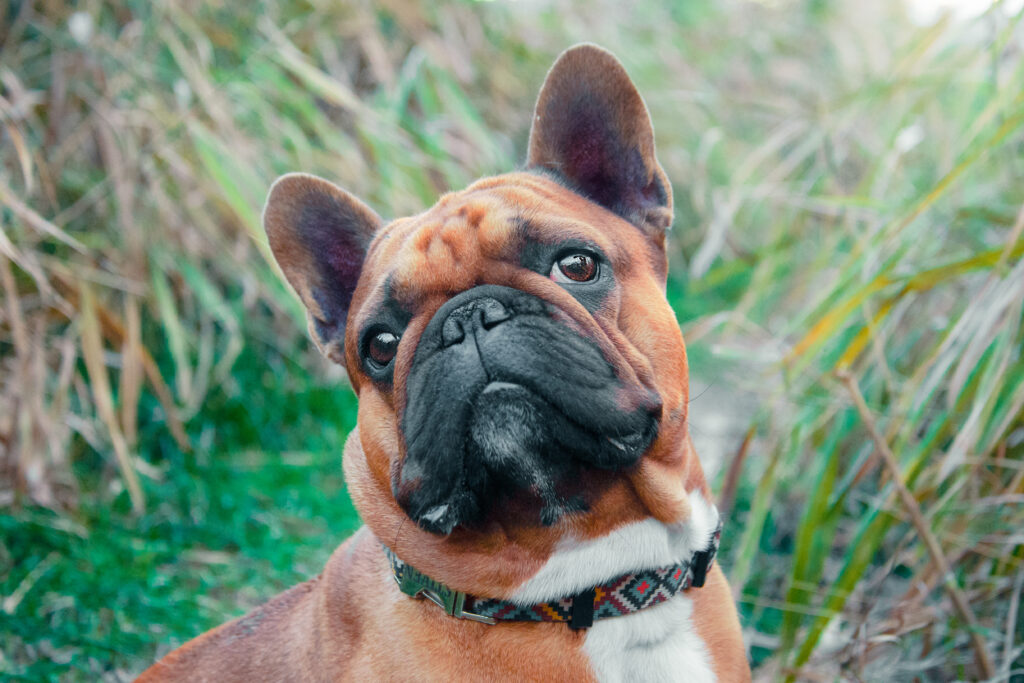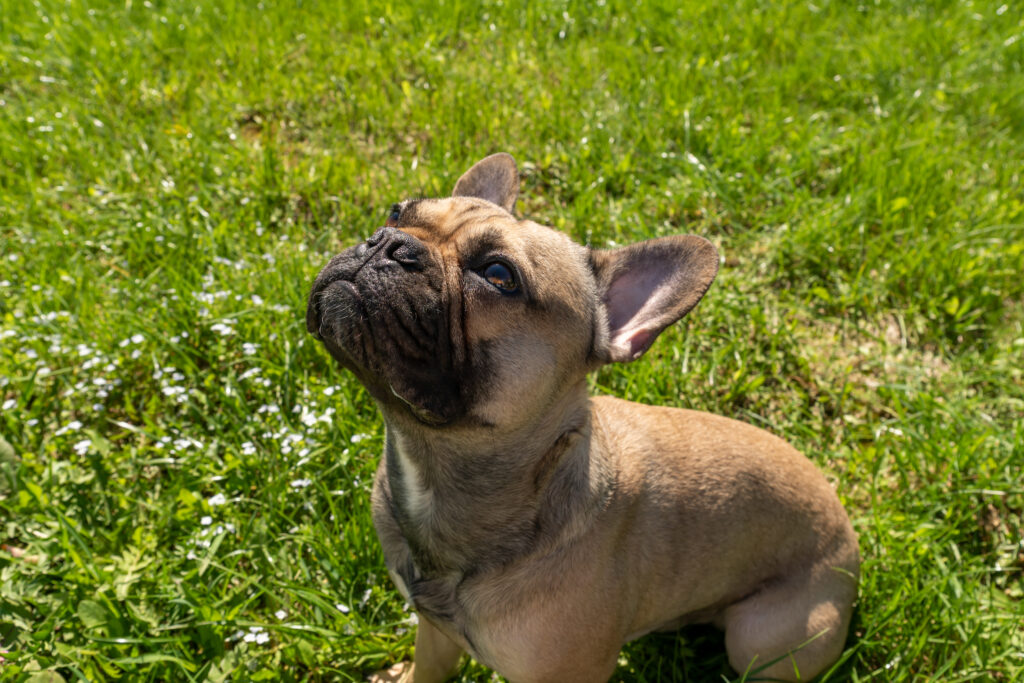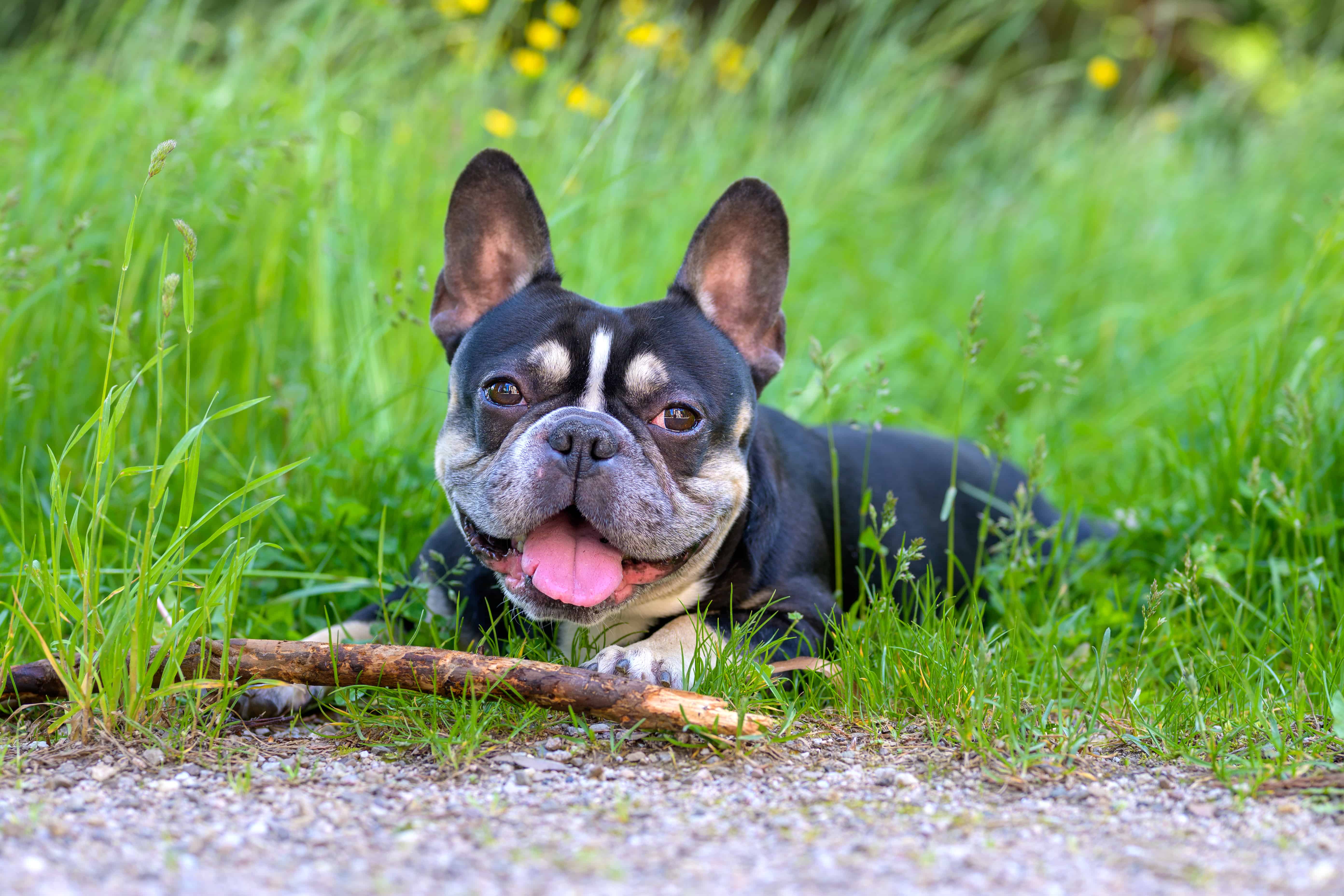French Bulldogs – or Frenchies for short – are constant attention seekers. With enough affection, a Frenchie can make the perfect companion dog, especially for owners with busy lifestyles and little time to provide physical exercise to their pets.
Frenchies love being at the center of attention and are easy-going creatures that do well with every family member. Their laid-back temperament combined with minimal care requirements (compared with other, high-energy breeds) makes them an ideal choice for first-time dog owners.
This article will cover everything you need to know about Frenchies, their history, what to expect as a French Bulldog owner, and answer commonly asked questions about the breed.
French Bulldog Breed Characteristics
- French Bulldogs are an easy-going breed and form good relationships with other dogs and pets in the family. They require close affection from their humans. If they don’t get the attention they need and are left alone even for a few hours, they may develop separation anxiety.
- The adult weight of a French Bulldog is between 16 and 28 lbs for males and 14 to 26 lbs for females. Both the males and females stand around 12 inches tall at the shoulders.
- Although Frenchies tend to be stubborn at times, they are very agreeable dogs. That’s why they go well with other pets and children in the family. This also makes them easier to train than some other breeds.
- French Bulldogs need minimal exercise. Even short walks of fifteen to twenty minutes are enough to keep this breed healthy when enough indoor space is provided.
- French Bulldogs are average shedders and need casual brushing to keep their coats smooth and healthy. Like Pugs and Bulldogs, the wrinkles on their skin should be cleaned after physical exercise to avoid dirt building up, which can lead to infection if neglected.
- French Bulldogs have dark eye colors, with some varieties having blue eyes. These blue-eyed Frenchies aren’t approved by the American Kennel Club.
- Frenchies come in a variety of colors. The standard colors of the French Bulldogs are different shades of brindle, cream, fawn, and white with dark patches.
- Because French Bulldogs were selectively bred, they have several health issues. The most common health problems include airway obstruction, ear infections, diarrhea, and butterfly hemivertebrae. Additionally, many Frenchies have trouble reproducing and require artificial insemination, with more than two-thirds of litters born this way.

History of the French Bulldog
The origins of the French Bulldog are closely tied to the English Bulldog and other Bulldogs that took part in bull-baiting. These dogs would lay flat on the ground and creep towards the bulls to get close, in an attempt to bite their nose or other sensitive areas like the neck to bring them down. Bull-baiting was a popular sport in England but was banned in 1835, leaving many Bulldogs without a job.
Around the same time, workers from Nottingham, England, began settling in Normandy, France, after being displaced by the Industrial Revolution. In a similar story to the origins of many other dog breeds, these workers brought their Bulldogs with them. However, not all Bulldogs become favorable in France. The smaller breeds which weighed 25 to 40 lbs were favored over the others. Soon, there became a fierce demand for these dogs, and breeders in England sent Bulldogs that were too small for their standards or had ‘flaws’ like stood-up ears – which the French actually favored. Historical notes also suggest these small Bulldogs were bred with Pugs and Terrier-type dogs to meet the liking of the French elites.
A few decades after first arriving in France, these smaller Bulldogs became thought of as a separate breed. People referred to them as Bouledogue Francais (translating to French Bulldog). In 1885, imports of the French Bulldogs to the US increased to make an American-based breeding program. The dogs that were a part of this breeding program became close companions of the elite class – influential families like the Rockefellers and J. P. Morgans made the breed’s popularity grow even more. By 1906, the French Bulldog became the fifth most popular breed in the United States. The American Kennel Club recognized the French Bulldog in 1911 with the following breed standards:
- Muscular dog of heavy bones
- Smooth coat
- Compact build
- Small to medium physical structure that’s well proportioned
- Intelligent, active, alert, and interested expressions

Current uses of the French Bulldog
French Bulldogs nowadays have come a long way from their bull-baiting ancestors. They make excellent companion dogs that do well in families of all sizes and are patient with children. When introduced to other pets in the family slowly and cautiously, French Bulldogs do well with them, including cats. However, they might boss around smaller dogs in the pack.
Frenchies go well with strangers, and it wouldn’t be a surprise for them to cuddle up to a new person in the home. Despite this affection to even strangers, they surprisingly make great watchdogs that will alert you when someone’s at the door. Nonetheless, don’t expect them to be guard dogs. Being a naturally loyal dog breed, French Bulldogs may pick one person in the house and become overly protective of them.
Overall, French Bulldogs today are incredible companion dogs that require minimal exercise. Short walks of fifteen to twenty minutes are enough to keep this breed healthy. This trait makes them excellent indoor pets, and with enough affection from their humans, French Bulldogs will return the favor.
The increasing popularity of Frenchies
In recent years, the Frenchie has become a fashionable and increasingly popular dog breed in many parts of the world. Their popularity in the United States has increased to such an extent that French Bulldogs are now the most popular dog in the United States, according to AKC registration details for 2022. This ended the Labrador Retriever’s 31 year reign in top spot.
The French Bulldog also ranked in seventh place in our 2022 analysis of the most popular dog breeds in the world.

French Bulldog FAQs
When fully grown, French Bulldogs stand 12 inches tall and weigh up to 28 pounds. They are a small-to-medium-sized breed that can adapt to apartment living easily – added with barking very little and requiring minimal exercise. Frenchies are an excellent consideration for people in busy cities living in small apartments.
Don’t expect a French Bulldog to have plenty of puppies in a single litter. They typically have two to four puppies in a litter, with more than four being incredibly rare.
Clean a French Bulldog’s ears by wiping the visible parts with a paper towel dampened with an ear cleaning solution for dogs. Avoid using water as it can irritate and soften the skin, leading to infections.
After cleaning the visible parts, wet a cotton ball with the ear cleaning solution and wipe the outside of the ear canal. Don’t stress about the ear cleaning solution getting in your dog’s ear canal. They will naturally have the urge to shake their head to remove the excess solution. Lastly, wipe the Frenchie’s ear with a soft paper towel or dry cloth.
Frenchies reach maturity at around 8 to 14 months old. Most will reach their full height between 9 and 12 months old, but they may continue to put on more muscle until they are two years old.
An Isabella French Bulldog is a coat variation found in the breed that is extremely rare. Also known as the Lilac French Bulldog, Frenchies with this coat color come in many shades, from dark to cream. Isabella French Bulldogs usually have light brown to blue eyes, which the AKC doesn’t include in its breed standards.
Feed your French Bulldog one and a half cups of dog food in three separate meals throughout the day. As the weight of the pup increases, you should increase the food portion accordingly. Your Frenchie should eat between 25 and 30 calories per pound of bodyweight every day. Check the nutritional information of the dog food you are feeding and create the portion sizes accordingly.
The average life expectancy of a French Bulldog is between 10 and 14 years. A proper diet, enough physical exercise, and regular vet visits are adequate to keep Frenchies at their best. Early diagnosis of the common health problems that affect French Bulldogs is crucial to help them live longer.
Read more in this series:
- About The Breed: Basset Hound
- About The Breed: Beagle
- About The Breed: Bloodhound
- About The Breed: Border Collie
- About The Breed: Bulldog
- About The Breed: Chihuahua
- About The Breed: Dachshund
- About The Breed: German Shepherd
- About The Breed: Greyhound
- About The Breed: Golden Retriever
- About The Breed: Labrador Retriever
- About The Breed: Pembroke Welsh Corgi
- About The Breed: Pomeranian
- About The Breed: Poodle
- About The Breed: Pug
- About The Breed: Siberian Husky
- About The Breed: Yorkshire Terrier
This article was originally published on March 28, 2022, and was updated on March 16, 2023.


You must be logged in to post a comment.